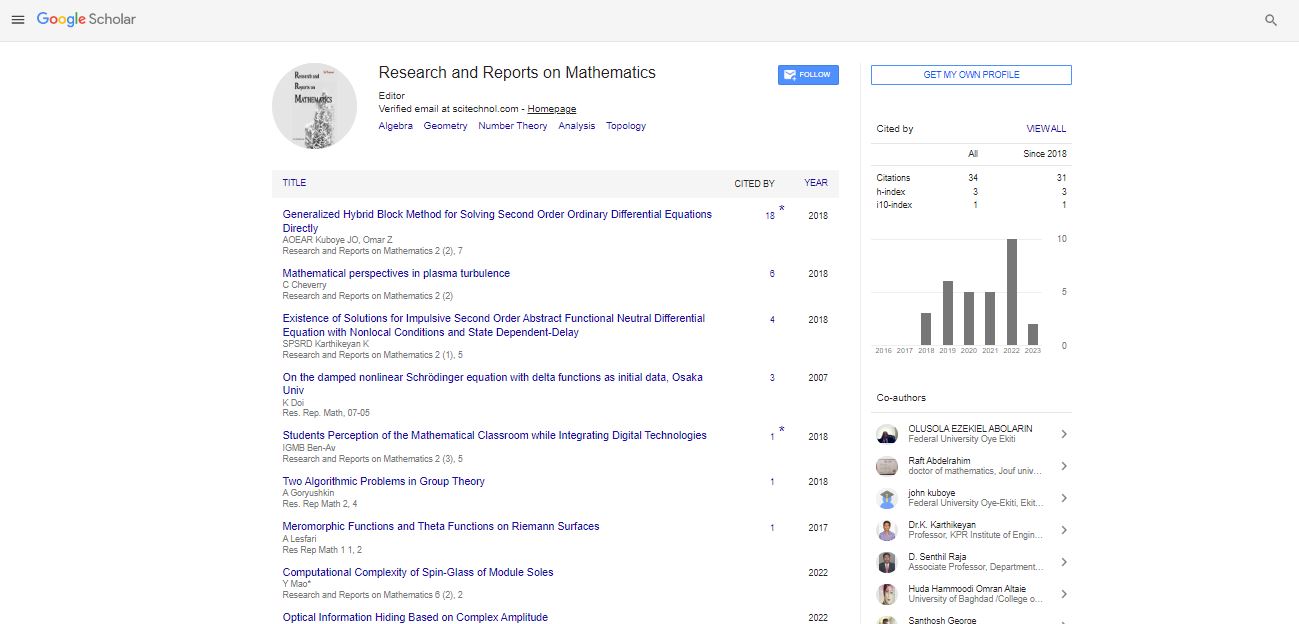Opinion Article, Res Rep Math Vol: 8 Issue: 1
Quantum Math: The Interplay of Quantum Mechanics and Number Theory
Karina Jones*
Department of Mathematics and Computer Science, University of Monash, Melbourne, Australia
- *Corresponding Author:
- Karina Jones
Department of Mathematics and Computer Science,
University of Monash,
Melbourne,
Australia
E-mail: karina123@gmail.com
Received date: 27 October, 2023, Manuscript No. RRM-23-118502;
Editor assigned date: 30 October, 2023, PreQC No. RRM-23-118502 (PQ);
Reviewed date: 13 November, 2023, QC No. RRM-23-118502;
Revised date: 11 January, 2024, Manuscript No. RRM-23-118502 (R);
Published date: 18 January, 2024, DOI: 10.4172/rrm.1000229
Citation: Jones K (2024) Quantum Math: The Interplay of Quantum Mechanics and Number Theory. Res Rep Math 8:1.
Description
The intriguing relationship between quantum mechanics, the branch of physics that describes the behavior of subatomic particles, and number theory, the study of the properties and relationships of integers. While seemingly disparate fields, they exhibit unexpected connections that offer insights into both quantum phenomena and the mathematical properties of numbers. This article delves into key intersections, such as quantum algorithms, quantum cryptography, and the role of number theory in understanding the quantum world, showcasing the symbiotic relationship between quantum math and these two diverse realms of science.
Quantum mechanics and number theory represent two distinctive domains of scientific inquiry one in the realm of subatomic particles and the other in the abstract world of integers. However, over recent decades, researchers have unveiled an unexpected interplay between these fields, opening up novel perspectives and practical applications. This manuscript explores the symbiosis between quantum mechanics and number theory, emphasizing the fascinating insights gained from their interaction.
Quantum algorithms and number theory
One of the most renowned intersections between quantum mechanics and number theory is Shor's algorithm. This groundbreaking quantum algorithm efficiently factors large numbers, a task crucial in cryptography and encryption. Shor's algorithm has the potential to revolutionize security protocols and cryptographic systems, making it both a mathematical and practical achievement in quantum computing.
The fusion of quantum computing and number theory is a captivating and rapidly evolving field that promises to revolutionize computation and cryptography. Quantum algorithms, with their inherent parallelism and quantum superposition, offer the potential to solve number-theoretical problems more efficiently than classical computers. This interplay between quantum mechanics and number theory explores how quantum algorithms tackle fundamental numbertheoretical challenges, from prime factorization to discrete logarithms. In this unique synergy, mathematical beauty meets quantum computing prowess, paving the way for groundbreaking applications in cryptography and computational mathematics.
The Quantum Fourier Transform (QFT) is a fundamental operation in quantum computing. It serves as the basis for quantum algorithms such as Shor's and Grover's algorithms. The QFT reveals profound connections between quantum mechanics and number theory, as it efficiently computes the discrete Fourier transform, a pivotal tool in signal processing and number theory.
Quantum cryptography and number theory
Quantum cryptography exploits the principles of quantum mechanics to create unbreakable encryption keys. It relies on the mathematical properties of quantum states and entanglement to secure communication. Number theory, particularly the theory of modular arithmetic, plays a central role in the design and analysis of quantum cryptographic protocols.
Prime numbers are at the heart of number theory, and they also find unexpected relevance in quantum mechanics. Primes play a pivotal role in quantum chaos theory, which explores the chaotic behavior of quantum systems. The distribution of prime numbers exhibits surprising connections with the energy levels of quantum systems, leading to insights into quantum chaos and spectral statistics.
Modular forms, a sophisticated branch of number theory, find applications in theoretical physics. They appear in the study of quantum field theory, where they play a role in understanding the properties of particles and their interactions.
The interplay between quantum mechanics and number theory continues to evolve, promising new avenues in both fields. Quantum algorithms, quantum cryptography, and number-theoretical concepts are at the forefront of research, paving the way for innovative applications in quantum computing, secure communication, and fundamental physics.
Conclusion
The relationship between quantum mechanics and number theory, once considered an esoteric bridge, has revealed profound insights and practical applications. The interplay of these fields, from quantum algorithms to quantum cryptography, primes, and modular forms, highlights the rich synergy between mathematics and physics. As the frontiers of quantum math expand, we can anticipate a deeper exploration of this fascinating interplay, with potential breakthroughs in science and technology.
 Spanish
Spanish  Chinese
Chinese  Russian
Russian  German
German  French
French  Japanese
Japanese  Portuguese
Portuguese  Hindi
Hindi 